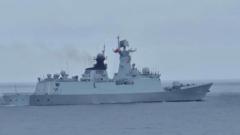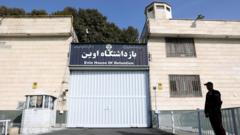Recent deployment of Chinese warships near Australia has seen Australian military on high alert, resulting in significant public concern about defense capabilities.
**Chinese Naval Maneuvers Intensify Tensions in Australian Waters**

**Chinese Naval Maneuvers Intensify Tensions in Australian Waters**
Chinese naval activities raise alarm in Australia, prompting discussions on military preparedness and reliance on U.S. defense.
The Chinese navy's maneuvering around Australia's coastline has highlighted critical issues within Australia's military capabilities and its reliance on American support, raising alarms about regional security dynamics.
In a noteworthy display of naval power, a flotilla from China entered Australian waters, triggering heightened readiness among local defense forces. Over the past month, three Chinese navy vessels, including a cruiser, a frigate, and a replenishment tanker, navigated in and out of Australia's exclusive economic zone, causing serious disruptions to civilian air traffic as live-fire exercises were conducted. With these vessels operating as close as 170 nautical miles to the city of Perth, their movements were particularly unsettling for Australian officials and the public.
Australia's government contended that the Chinese ships were acting in accordance with international maritime laws; nonetheless, the incursion has catalyzed an ongoing debate concerning Australia’s aging navy fleet and the nation’s heavy military reliance on the United States, its principal defense ally. Analysts have noted the striking imbalance between the capabilities of the Australian and Chinese fleets. While the Royal Australian Navy comprises merely ten warships and includes just two operational tankers, the two Chinese vessels boast a collective 144 vertical launch missile systems compared to Australia's total of 200 for all its vessels combined.
As Australia grapples with increasing assertiveness from China, these developments underscore the urgent need for reevaluation within Australia's defense strategy. This situation presents a critical juncture for Australian policymakers who must weigh the implications of their military reliance on foreign powers against the backdrop of an evolving regional security landscape.
In a noteworthy display of naval power, a flotilla from China entered Australian waters, triggering heightened readiness among local defense forces. Over the past month, three Chinese navy vessels, including a cruiser, a frigate, and a replenishment tanker, navigated in and out of Australia's exclusive economic zone, causing serious disruptions to civilian air traffic as live-fire exercises were conducted. With these vessels operating as close as 170 nautical miles to the city of Perth, their movements were particularly unsettling for Australian officials and the public.
Australia's government contended that the Chinese ships were acting in accordance with international maritime laws; nonetheless, the incursion has catalyzed an ongoing debate concerning Australia’s aging navy fleet and the nation’s heavy military reliance on the United States, its principal defense ally. Analysts have noted the striking imbalance between the capabilities of the Australian and Chinese fleets. While the Royal Australian Navy comprises merely ten warships and includes just two operational tankers, the two Chinese vessels boast a collective 144 vertical launch missile systems compared to Australia's total of 200 for all its vessels combined.
As Australia grapples with increasing assertiveness from China, these developments underscore the urgent need for reevaluation within Australia's defense strategy. This situation presents a critical juncture for Australian policymakers who must weigh the implications of their military reliance on foreign powers against the backdrop of an evolving regional security landscape.





















